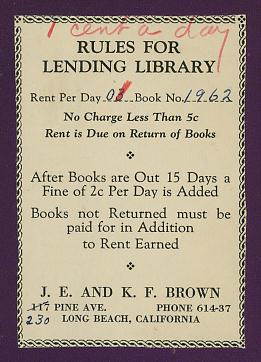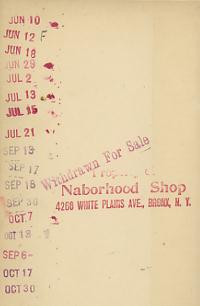NOTE: This is a relatively new page that I just "thunk up" while I was scanning my book collection for new additions to the Bookseller's Labels page (which see). So it's just a-borning, so to speak, which is meant to explain why there's not (yet) much to see. Nor have I given any real thought to just what I want to say, but it'll probably go something like this.....
In modern times, when we take for granted (although we shouldn't!) the presence of public libraries all over the place, it may come as a surprise to some that, back in the so-called good old days, there were a tremendous number of "rental libraries," which name implied exactly what you might think it would: books for rent, by the day or week. The amounts involved -- nickels and pennies, essentially -- look absurdly small to our eyes today, but especially during the Great Depression, when you could get a good square meal (including pie) at a restaurant or automat for 15 or 20 cents, this kind of money was not insignificant for many people. The rental libraries tended to carry a wide range of popular fiction, often including books with "racy" themes (abortion, common-law marriage, adoption, artificial insemination, etc etc.) that rendered them more or less off-limits for regular public libraries, which were supported by public money and thus (like today) a ready target for the various cranks and crusaders who were/are always up in arms about "indecent" literature and so forth. Essentially, a lot of the novels carried by the rental libraries were out-and-out trash, or at the very least were marketed as such, with lurid jacket illustrations and catchy, tantalizing titles (Strange Bedmates; Burn, Baby Burn!; Unmarried Wife; Strange Brother) ["Strange" was a much-used descriptor for this type of lit]. In the Depression-Era heyday of the rental libraries -- it was estimated that in 1935 there were 50,000 in the U.S. alone (five times the number of free public libraries!), several publishers (most notably The Macaulay Company and Phoenix Press) were kept busy churning out books that were directly targeted at this market.

